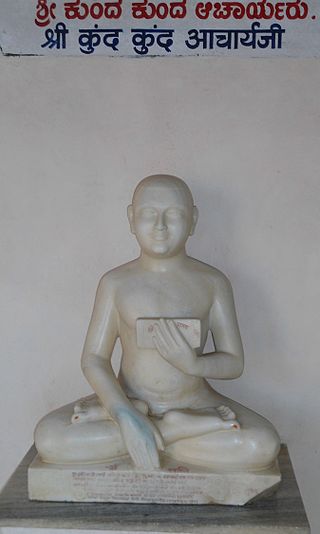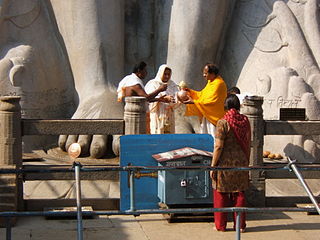Related Research Articles
Jainism, also known as Jain Dharma, is an Indian religion. Jainism traces its spiritual ideas and history through the succession of twenty-four tirthankaras, with the first in the current time cycle being Rishabhadeva, whom the tradition holds to have lived millions of years ago, the twenty-third tirthankara Parshvanatha, whom historians date to the 9th century BCE, and the twenty-fourth tirthankara Mahavira, around 600 BCE. Jainism is considered an eternal dharma with the tirthankaras guiding every time cycle of the cosmology. The three main pillars of Jainism are ahiṃsā (non-violence), anekāntavāda (non-absolutism), and aparigraha (asceticism).

Mahavira, also known as Vardhamana, was the 24th Tirthankara of Jainism. He was the spiritual successor of the 23rd Tirthankara Parshvanatha. Mahavira was born in the early 6th century BCE to a royal Jain family of ancient India. His mother's name was Trishala and his father's name was Siddhartha. They were lay devotees of Parshvanatha. Mahavira abandoned all worldly possessions at the age of about 30 and left home in pursuit of spiritual awakening, becoming an ascetic. Mahavira practiced intense meditation and severe austerities for twelve and a half years, after which he attained Kevala Jnana (omniscience). He preached for 30 years and attained moksha (liberation) in the 6th century BCE, although the year varies by sect.

Tattvārthasūtra, meaning "On the Nature [artha] of Reality [tattva]" is an ancient Jain text written by Acharya Umaswami in Sanskrit, sometime between the 2nd- and 5th-century CE.

Jain monasticism refers to the order of monks and nuns in the Jain community and can be divided into two major denominations: the Digambara and the Śvētāmbara. The monastic practices of the two major sects vary greatly, but the major principles of both are identical. Five mahāvratas, from Mahavira's teachings, are followed by all Jain ascetics of both the sects. Historians believe that a united Jain sangha (community) existed before 367 BCE, about 160 years after the moksha (liberation) of Mahavira. The community then gradually divided into the major denominations. However, no evidences indicate when the schism between the Digambaras and the Śvetāmbaras happened.
Pratikramana, is a ritual during which Jains repent (prayaschit) for their sins and non-meritorious activities committed knowingly or inadvertently during their daily life through thought, speech or action.

Karma is the basic principle within an overarching psycho-cosmology in Jainism. Human moral actions form the basis of the transmigration of the soul. The soul is constrained to a cycle of rebirth, trapped within the temporal world, until it finally achieves liberation. Liberation is achieved by following a path of purification.

Jain meditation has been the central practice of spirituality in Jainism along with the Three Jewels. Jainism holds that emancipation can only be achieved through meditation or Shukla Dhyana. According to Sagarmal Jain, it aims to reach and remain in a state of "pure-self awareness or knowership." Meditation is also seen as realizing the self, taking the soul to complete freedom, beyond any craving, aversion and/or attachment. The 20th century saw the development and spread of new modernist forms of Jain Dhyana, mainly by monks and laypersons of Śvētāmbara Jainism.
Jain rituals play an everyday part in Jainism. Rituals take place daily or more often. Rituals include obligations followed by Jains and various forms of idol worship.
Jain philosophy or Jaina philosophy refers to the ancient Indian philosophical system of the Jain religion. It comprises all the philosophical investigations and systems of inquiry that developed among the early branches of Jainism in ancient India following the parinirvāṇa of Mahāvīra. One of the main features of Jain philosophy is its dualistic metaphysics, which holds that there are two distinct categories of existence: the living, conscious, or sentient beings (jīva) and the non-living or material entities (ajīva).

Jain literature refers to the literature of the Jain religion. It is a vast and ancient literary tradition, which was initially transmitted orally. The oldest surviving material is contained in the canonical Jain Agamas, which are written in Ardhamagadhi, a Prakrit language. Various commentaries were written on these canonical texts by later Jain monks. Later works were also written in other languages, like Sanskrit and Maharashtri Prakrit.
Michchhāmi Dukkaḍaṃ, also written as michchha mi dukkadam, is an ancient Indian Prakrit language phrase, found in historic Jain texts. Its Sanskrit equivalent is "Mithya me duskrtam" and both literally mean "may all the evil that has been done be in vain".
The karmic process in Jainism is based on seven truths or fundamental principles (tattva) of Jainism which explain the human predicament. Out of those, four—influx (āsrava), bondage (bandha), stoppage (saṃvara) and release (nirjarā)—pertain to the karmic process. Karma gets bound to the soul on account of two processes:

The Samantabhadra Meditation Sūtra, also known as the Sūtra of Meditation on the Bodhisattva Universal Virtue, is a Mahayana Buddhist sutra teaching meditation and repentance practices.

Umaswati, also spelled as Umasvati and known as Umaswami, was an Indian scholar, possibly between 2nd-century and 5th-century CE, known for his foundational writings on Jainism. He authored the Jain text Tattvartha Sutra. Umaswati's work was the first Sanskrit language text on Jain philosophy, and is the earliest extant comprehensive Jain philosophy text accepted as authoritative by all four Jain traditions. His text has the same importance in Jainism as Vedanta Sutras and Yogasutras have in Hinduism.
Jainism and Hinduism are two ancient Indian religions. There are some similarities and differences between the two religions. Temples, gods, rituals, fasts and other religious components of Jainism are different from those of Hinduism.

The Five Vows of Jainism include the mahāvratas and aṇuvratas.

In Jainism, the word Śrāvaka or Sāvaga is used to refer to the Jain laity (householders). The word śrāvaka has its roots in the word śrāvana, i.e. the one who listens.
Sāmāyika is the vow of periodic concentration observed by the Jains. It is one of the essential duties prescribed for both the Śrāvaka (householders) and ascetics. The preposition sam means one state of being. To become one is samaya. That, which has oneness as its object, is sāmāyikam. Sāmāyika is aimed at developing equanimity and to refrain from injury.

Āchārya means the Head of an order of ascetics. Some of the famous achāryas are Bhadrabahu, Kundakunda, Samantabhadra, Umaswami, Sthulibhadra.
Jains are broadly divided into 2 major groups. These include the Digambara, whose clothing displays symbols of cardinal directions, and the Svetambara who wear white clothes. Both of the groups are similar in their ideology but differ in some aspects.
References
Notes
- ↑ Tatia 1994, p. 293.
- 1 2 Dundas 2002, p. 170.
- ↑ Dundas 2002, p. 171.
Sources
- Dundas, Paul (2002) [1992]. The Jains (2nd ed.). Routledge. ISBN 0-415-26605-X.
- Tatia, Nathmal (1994). That Which Is. Institute of Jainology. ISBN 0-06-068985-4.
